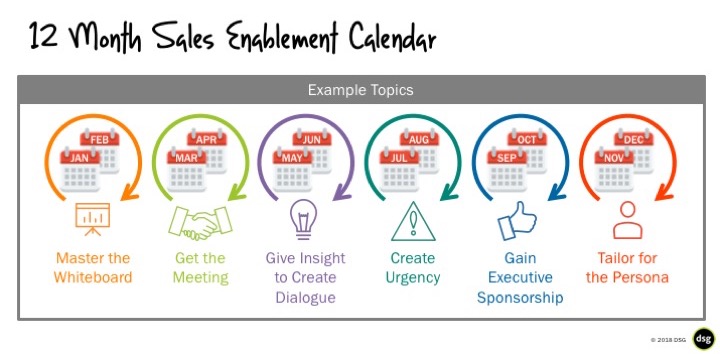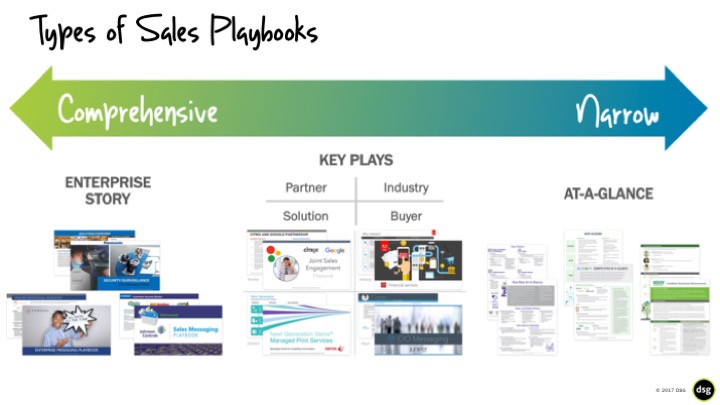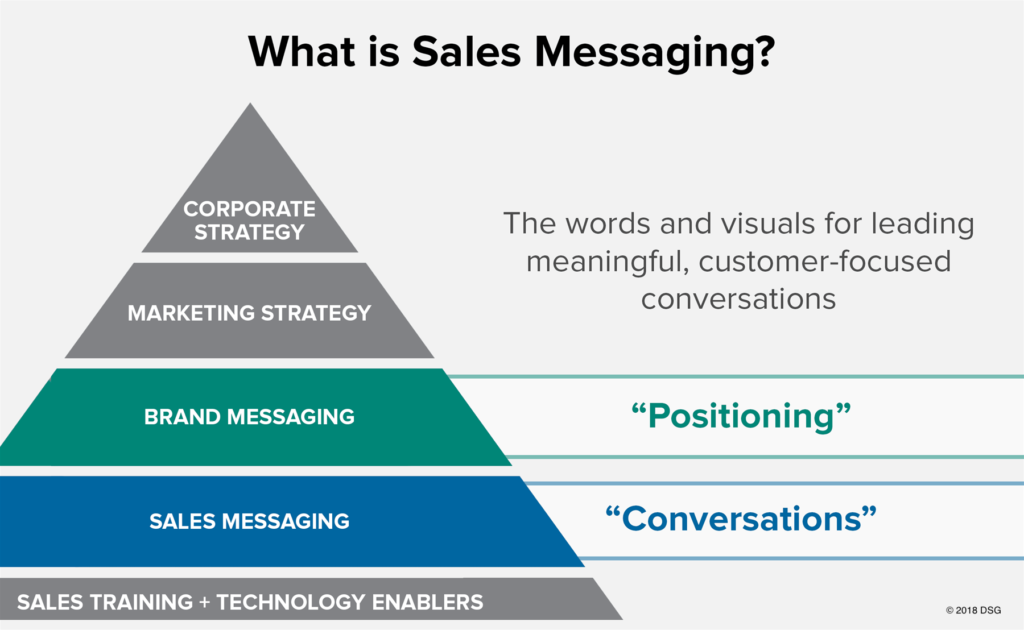In our fast-paced world where modern-day buyers are more demanding than ever, sales enablement comes to play a crucial role in sellers’ success. But there’s more to it than that. Not only do companies need the right sales enablement solution — they need the right approach.
This is one reason why we’re excited to share insights and advice from Matt McClendon, President of DSG, as part of our Highspot “Hot Shots” series. Matt has a passion for creating sales-friendly playbooks and helping clients provide their sales channels with the content, tools, and training required to lead compelling customer conversations. DSG has provided professional services, creative services, and enablement tools to hundreds of B2B companies and more than 100,000 salespeople.
What do you see as the most critical aspect of sales enablement and why?
Creating a sales enablement strategy and implementation plan is the most critical aspect of sales enablement. Without a documented plan, everything is important, so nothing is important. Competing interests can overwhelm sales. Enablement will try to do everything for everybody when there’s not a clear strategy, so you’ll be more reactive with the sales enablement content and tools produced.
Create a calendar around your sales enablement strategy, and create alignment around the plan. Everyone needs to buy in to the plan, from executives to regional management. Use the plan to align marketing campaigns, product launches, and key sales plays. Then, package the content, tools, and training needed to implement your enablement calendar. Beginning with the end in mind will be motivating for your sales, marketing, and product teams.

What are your key performance indicators for sales enablement — how do you determine success?
Determine success with performance indicators tied to an organisation’s sales strategy. It’s most helpful when performance indicators connect to specific sales initiatives. Leading indicators are also a good way to communicate progress, showing an indication that you’re on the right path. Here are examples of leading and performance indicators:
- Leading Indicators: Number of conversations, number of follow-up meetings, pipeline growth, pipeline velocity (movement between stages)
- Performance Indicators: Number of deals, average size of deals, percentage of sales team making quota
What three trends do you see today in sales enablement processes and technology?
- Playbooks: A sales playbook consists of content and strategies focused on preparing salespeople to be successful in their calls, meetings, and presentations. Using a playbook structure, marketing and enablement teams can better equip sales reps by creating and managing the right target messaging, content, and strategies for every audience. Having your sales playbooks available in a digital format is key to ensuring content is interactive and always current while fitting into the mobile lifestyles of your salespeople. We find that it’s helpful to create sales playbooks around a certain sales play or selling strategy. The play can be a comprehensive enterprise story or narrowly focused on a specific vertical, persona, or product area.

- Directive Selling: This trend is about serving up the right content to salespeople at the right time. Directive selling serves relevant content in the context of a lead, account, contact, or opportunity through integration with CRM, LMS, or sales enablement platforms. This approach creates efficiency and can help a change in sales strategy move quicker, allowing companies to sell “our way” faster. Given X scenario, present X best practices, content, or KPIs that are relevant in that context. Your sales team is always informed by the best practices, producing outcomes of their top performing sales colleagues.
- Managers as Coaches and Trainers: The most significant leverage opportunity for many companies is unlocking the value of first-line sales managers to be more than super reps. Managers can add more value as coaches. More companies are seeing this opportunity gap and want to invest in managers. By using a coaching framework, you can enable managers to use their experience across the team. For example, use managers to train to the product launch, then managers work toward certification of their team on mastery of the new message. Build a repeatable cadence of meetings for your managers. Help them anticipate the weekly, monthly, quarterly, and annual meetings required to effectively lead their team as a coach and a trainer. Provide content, tools, and training built specifically to increase your sales managers’ effectiveness and efficiency.
What advice do you have for someone who is looking to modernise and enhance sales enablement processes in their organisation?
A modern sales enablement process should be lead by a cross-functional core team representing sales, sales management, product, and marketing. We’ve found it to be critical for investment of time and resources to be focused on 4 repeatable phases of a sales enablement process:
Phase 1—Define
- Assess your current state through discovery interviews and voice of the field feedback
- Conduct an executive planning workshop to develop a shared “change vision” and create the inputs for a well-defined sales enablement plan
- Create a holistic sales enablement plan including milestones, timeline, roles, quick wins, change management requirements, training requirements, metrics, and measurement mechanisms
Phase 2—Build
- Create sales messaging playbooks that increase sales confidence and ability to deliver new messages and insights, engage new buyers, and lead compelling sales conversations
- Create a sales coaching playbook that equips the sales leadership team to effectively and consistently coach to the strategy, messaging, and processes to ensure lasting results
Phase 3—Launch
- Deliver experiential sales team training
- Deliver sales leadership training focused on enabling managers to operate as sales coaches and change leaders
Phase 4—Enable
- Reinforce content, tools, and training through on-demand training modules, webinars, and accreditation
- Refresh playbook content including the capture and distribution of sales success stories, updated messaging, and the addition of new tools
What is a sales playbook, and why is having one important?
“Playbook” can mean a lot of different things. We view sales playbooks as the practical tools and information salespeople need to do and say for their next customer conversation.
Sales playbooks are important because this level of communication to sales is often missing. Your company may have a sales process and brand positioning, but salespeople need simple, practical resources for leading the meeting. We call that level of content “sales messaging.”

Your company is filled with the knowledge and information that your salespeople need to be successful. But that helpful information may be scattered across different team members and departments. Sales playbooks should combine the best and most useful best practice info in a format that best serves your sales reps. Playbooks can cover everything from preparation to presentation including guidance on sales strategy, messaging, process, and coaching.
What are the new standards for modern sales playbooks?
- Just-in-time tool that’s mobile-friendly for on-the-go salespeople
- Focused, not encyclopaedic; a playbook is not necessarily exhaustive knowledge — make decisions about what’s important to include
- Web-based and interactive (ex: video is a great resource for adult learning)
- Connect playbooks to where the customer is in the buying process
- Always improve playbooks, informed by the latest and greatest thinking
- Sequence content delivery to the sales team over time, not in a big data dump that will overwhelm salespeople
- Connect playbooks to other systems of record (ex: CRM, CMS, LMS, Portal)
What role do sales enablement platforms play in helping teams create and maintain winning playbooks?
Sales enablement platforms provide helpful analytics of what sales assets are being used, where, and when. Those engagement analytics can create valuable insight, informing what content and tools should be created next for your sales team. Also, the ability of sales enablement platforms to have all the content in one source is valuable. Your sales team can spend less time trying to find the right selling assets and more time selling.




